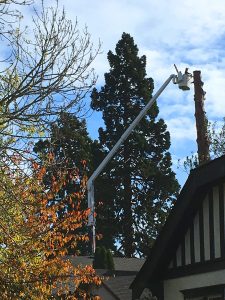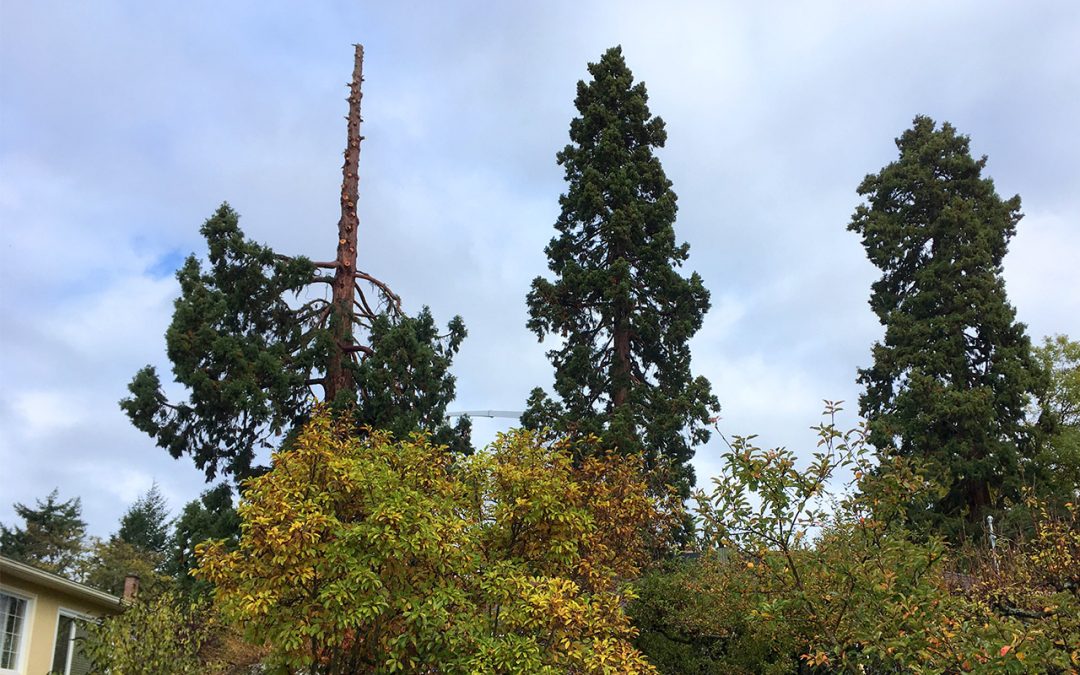Council already understands the many reasons to increase the urban forest in Victoria. City staff are already protecting public trees as well as they can with the budget they have. My focus is on protecting trees on private land.
So far, my family and friends in Victoria have been supportive of increasing density and affordable housing, but always conditional on saving mature trees. That’s not working out so well. Every new loss is eroding our support for density. Updating and enforcing bylaws costs money, as does educating and consulting with citizens. But Victoria is booming, revenues should be rising and the trees are under more pressure than ever. If not now, when? Every delay costs more trees.
 In October, a healthy Giant Sequoia on Langham Court died because of an infill home with a completely predictable conflict with a sewage line. That beloved tree was there long before the house was and could have lived another 1000 years or more. That loss broke my heart and my tears have turned to political action. We can learn from this. We can value big trees as much or more than we value buildings.
In October, a healthy Giant Sequoia on Langham Court died because of an infill home with a completely predictable conflict with a sewage line. That beloved tree was there long before the house was and could have lived another 1000 years or more. That loss broke my heart and my tears have turned to political action. We can learn from this. We can value big trees as much or more than we value buildings.
Speaking of buildings… My first request is that the City of Victoria amend its strategic plan operational priority about heritage. The current draft says: Heritage Conservation and Heritage Designation. It could say: Designation and conservation of natural and built heritage. In practice, that isn’t easy. From my career at the Islands Trust, I understand BC’s Community Charter limits municipal authority on private land. I am also aware there are cities, under the same constraints, with much stronger tree protection policies. Vancouver’s bylaw sets a 20 cm diameter minimum for protection instead of our 80 cm. Many cities require developers to give more amenities, which can include trees. And there are proven incentive programs to help landowners protect trees.
My second request to mayor and council is to dedicate money and staff to the urban forest. They need to budget for a permanent staff position – and expenses – to review the bylaw and implement the 2013 Urban Forest Master Plan, all starting in 2019. Give this position the authority to work with all three departments responsible for trees: parks, engineering and development. Development staff have the first contact with landowners, can suggest ways to preserve trees earlier in the application process, and in rezonings, they can request amenity contributions – including trees.
We also need an immediate inventory of significant trees, perhaps starting with a public nomination process like Saanich has. Knowing the species, size, number and location of significant trees will root the bylaw update process in reality and make bylaw enforcement more effective.
 As part of Victoria’s climate adaptation plan, we need policies that encourage more drought-hardy trees; we need neighbourhood-based targets for increasing Victoria’s tree canopy; and we need urban forest staff to participate in local area planning processes.
As part of Victoria’s climate adaptation plan, we need policies that encourage more drought-hardy trees; we need neighbourhood-based targets for increasing Victoria’s tree canopy; and we need urban forest staff to participate in local area planning processes.
To help landowners, we need to explore financial incentives for tree protection. A few years ago some of Victoria’s elected officials voted at UBCM to endorse a program called the Conservation Tax Incentive Program (CTIP). The 2013 Urban Forest Master Plan doesn’t mention those programs, but there is a track record in BC and other
jurisdictions we can learn from.
We need greater transparency to the public by reporting annually on a) permits approved and denied for tree removal by size, species and location, b) species and locations of new trees planted (not including those on rooftops or in containers), and c) annual canopy loss / gain by neighbourhood.
Finally, how about convening an Urban Forest Advisory Group to support the above tasks. The group could work with staff to review best practices in other jurisdictions, including financial incentives to private landowners and options to reduce conflict between utilities and mature trees. I would happily serve on this group and know other willing to serve, with love.
